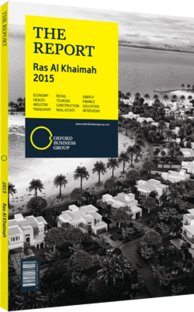Cement and rock industries focus on new green regulations in Ras Al Khaimah
The rock and cement industry in Ras Al Khaimah helped build the world’s highest skyscraper, Dubai’s Burj Khalifa, but is now being monitored by unmanned observation planes. This was announced by Saif Mohammed Al Shara, assistant under-secretary for external audit at the Federal Ministry of Environment and Water (MoEW) in May 2015. “This technology ushers in a new phase in round-the-clock inspection and monitoring of crusher and quarry activities to ensure none are in violation of facility regulations,” said a statement from the MoEW.
Hi-Tech
The ministry said use of unmanned aerial vehicles, which are fitted with 3D imaging and recording equipment, is to monitor and react to any “irregularities” that might pose a threat to public health and safety. The statement added: “The most important of these irregularities are the thick dust emissions from operations, dense fumes from exhaust engines and equipment, thick dust from the roads, as well as the inadequate maintenance of dust controlling systems, and covers of cracker units.”
The introduction of the surveillance measures came a few months after a lengthy debate by the UAE’s Federal National Council (FNC), which passed a new amendment to Clause 44 of the country’s environmental protection legislation, requiring quarries and cement companies to adhere to national laws. FNC members from RAK argued against the clause, saying that individual emirates should have the right to manage their own natural resources. Local daily The National reported that major objections were raised by FNC member Ahmed Al Amash, who is also the managing director of Gulf Cement. The firm is RAK’s biggest producer, and has an annual capacity of 2.7m tonnes of cement and 3.8m tonnes of clinker. Prior to the debate, local newspapers reported that in October 2014, a cement plant in RAK was closed for a month by federal inspectors who said they had found a number of violations. The name of the factory was not released, and none of the four RAK cement firms listed on the Abu Dhabi Securities Exchange published any notifications of a closure to shareholders.
Strategy
Various green initiatives are taking place as part of the UAE’s Vision 2021, and in December 2012 the country submitted its response to the UN Framework Convention on Climate Change, detailing sources of greenhouse gas emissions and outlining its strategy for improvement. The data on greenhouse gas emissions was gathered in 1994, 2000 and 2005.
According to the report, 2005 data showed that the UAE produced 174,357 gigagrams (Gg) of CO equivalent, with industry accounting for 5.4% of the total, or 9426 Gg of CO equivalent. The report went on to state that the UAE’s cement, limestone and dolomite industries were responsible for nearly 68% of industry’s emissions, or 6406 Gg of CO which equated to 3.67% of all UAE CO 2005. In the same year the energy industry accounted for 88.2% of emissions, or 153,833 Gg of CO alent. Among the steps being taken to reduce the country’s carbon footprint outlined in the report was the use of technology to reuse waste heat reserves at Union Cement, which it said had resulted in a savings of 668,250 tonnes of CO equivalent.
Coal
In 2013 similar technology was introduced at Gulf Cement, which has its own gas turbine power plant that produces 27 MWh. RAK Cement also has a gas turbine, but its site is designed to operate on coal as well, and for the last seven years has been using the cheaper fuel. The plant’s management said cement companies in other GCC countries can produce cement at 40-45% of the production cost in RAK, because the fuel in those countries is highly subsidised. “MoEW staff are working very hard in the UAE, and every month new rules are coming out,” Ahmed Ali Al Nuaimi, RAK Cement Company’s general manager, told OBG. “I think that in three or four years we will not be able to use coal any more.”
You have reached the limit of premium articles you can view for free.
Choose from the options below to purchase print or digital editions of our Reports. You can also purchase a website subscription giving you unlimited access to all of our Reports online for 12 months.
If you have already purchased this Report or have a website subscription, please login to continue.

